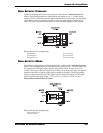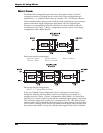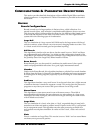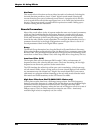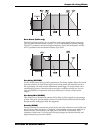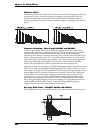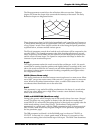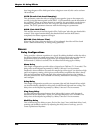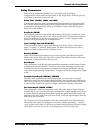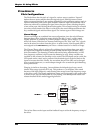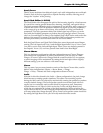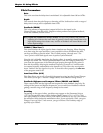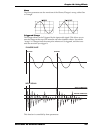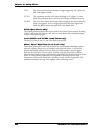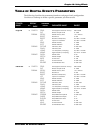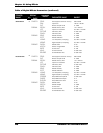
Chapter 10: Using Effects
ANDROMEDA A6 REFERENCE MANUAL 221
Delay Parameters
Some of these parameters (Feedback, etc.) are found in all of the Delay
configurations, where others are found only on the single delays. Following is a list
of all Delay parameters found in the A6:
Delay Time (100MS, 10MS, and 1MS)
In most cases, the delay time is separated into three parameters for fine-tuning the
time: 100mS (milliseconds), 10mS, and 1mS. Maximum delay time depends on the
configuration; the Mono Delay offers up to 5499mS of delay while the Ping Pong
delay offers only 2499mS.
Feedback (FDBK)
The Feedback parameter controls the regeneration of the delay. If feedback is set for
0, you will only hear one delay. If it is set for 99, the delay will continue to repeat for
days. The feedback can also be set for negative values (-1 to -99). Negative values
produce out-of-phase delays for a thinner sound.
Low Cut/High Cut (LOCUT/HICUT)
These parameters filter the input and feedback of the delay. They can be used to
make a “warmer” or “thinner” delay sound. The filters can each be set for Off or
29Hz to 41.3kHz and they roll off at 6dB per octave.
Density (DENS)
Similar to the Density parameter on the reverb programs, this adds several quick
delays to the initial delay time. This effect “smears” the delayed sound, so the result
is more like a small room than a discrete echo.
Rate/Depth
These parameters work like the pitch modulation parameters on the Chorus/Flange
configurations (see next section). This allows you to add chorusing to a delay for a
richer effect. Used in conjunction to the tremolo and autopan parameters, you can
even create unique panning chorus effects. To bypass this effect, simply set the Depth
to 000.
Tremolo Rate/Depth (TREMR, TREMD)
This effect adds a tremolo effect to the delay return. You can use it as a simple
tremolo by setting the delay time to 000mS and the Tremolo depth and Delay Mix to
100%. Or, you can use it in conjunction with the delay to produce delays which fade
in and out. Rate controls the speed and Depth controls the intensity of the effect.
Pan Rate/Depth (PANR, PAND)
These parameters control an autopanner which effects the delayed signal. Like the
Tremolo effect, you can set the delay time to 000mS for a simple autopan effect or use
it with the delay for panning delays. Rate controls the speed and Depth controls the
intensity of the effect. Make sure you have the OUT level set high enough to hear the
effect of the pan or tremolo.
Tip: Note that all of the modulation effects have similar Rate scales. By setting the
rates to the same values (or multiples of each other; double, quadruple, ...) you can
“sync” them to each other. Use this trick to create swirling, panning choruses, flanges
which fade in and out every cycle, or anything else you can come up with.



